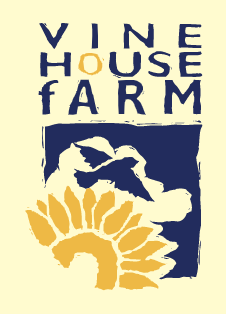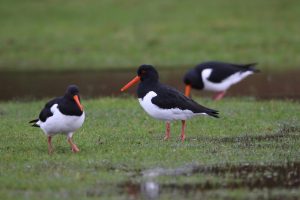
May has been wetter than average, here at Deeping St Nicholas, with 53.4mm or 2.1” of rain but the ground is still very dry. Because April was very dry, the rain fell on dry ground. Rainfall has been very variable – 20 miles to the East over 3” have fallen, while 10 miles to the west only 1” has fallen. While the average temperature for the past 50 years is 11.9°C, May has also been colder than average, at 11.4°C.

May is the month when we sow the millet and the sunflowers, and sometimes potatoes, but as the previous month was so dry, all the potatoes were planted in good conditions during April.
Before the sunflowers are planted, the millet is drilled about 1” or 2” deep into a moist seedbed and it soon gets away. We were lucky that the first 10 days of May were quite wet and so all the millet germinated and is now well up. The sunflower drilling is also quite easy, they are bigger seeds so can be drilled deeper.
We drill the seeds on 18 inch-wide rows and about seven inches apart, and around 50,000 seeds per acre. This year, as last year, the weather came warm as they emerged so they came up quite quickly and we now have a good plant all over the fields.
What happens after the drilling is crucial – emerging sunflowers are very tasty to pigeons, pheasants and partridges, even the loud gas guns that we put out in the fields are no use, they are ignored when there are emerging sunflowers to eat. We also fly kites before the sunflowers start to emerge, which are effective only when it is windy enough. Typically at dawn and dusk there is no wind, so the only way to really keep the birds off the field is to have a person walking around with a white flag. Even then, pheasants creep out from the hedge, or the dyke, and start nibbling away at them. Pigeons also land on the edge of the field and are not very visible; something blue grey on grey soil doesn’t stand out.
For the last two years we have covered the 12 metre outside edge of our sunflower fields with fleece. Field fleece has a dual purpose and is in use a lot around here where farmers grow brassicas. Not only do they protect against pigeons, but they also warm up the soil which helps crops grow more quickly.
Sunflowers are unlike other seeds, as most seeds when sown put a root into the ground and a shoot up, with the seed staying where it was put. The sunflower however puts a root down and the seed is then forced up. As it emerges, it breaks into two halves to form the cotyledons. If anything should eat that emerging seed, that is the end of that plant.
If two pigeons were left on their own on a one acre field they would eat nearly all of them as they emerged. This is why there are so few sunflowers grown in England, as pigeons are a big problem. France and Spain don’t have this issue because there are very few pigeons around in the summer as water is not freely available and a pigeon can only breed where there is lots of water.
Pigeons don’t have insects in their diet, they eat grain and then have a drink, their digestive system turns that into pigeon milk, which they regurgitate to their young. Every bird has to feed their nestlings moist food as they can’t take them water. Most birds use meat as a moist food, insects are a small portion of meat As far as I know, the only bird that takes its young water is the Sandgrouse. The adults will fly several miles to get to water, have a bathe in the water and fly back to their young without having a good shake and the young drink the water from their breast feathers.


May is the month when I do most of my bird surveys. I am out every suitable morning at 5am to start a survey, some are done for myself and some are done for the BTO, The British Trust for Ornithology.
This year I needed to do some of my early May surveys in advance in April, as I had a week away at the start of the month bird watching and farming in Belarus. Belarus was once part of Russia and it doesn’t seem to have altered much, all the state farms are still intact and all the state farms have a large dairy herd. A holiday in Russia, or Belarus, is not always a good holiday but I find it a good experience. You can read more about my Belarus experience on the Vine House Farm website.
This May, there have been many ideal survey mornings. I have enjoyed seeing and listening to Sedge Warblers, Whitethroats, Skylarks, Reed Buntings, Reed Warblers and Cuckoos in nice conditions. During my surveys in April and May, I walk a total of about 90 miles, starting at sunrise and finishing within two hours.
This year I have a 25% increase in Sedge Warblers and at Baston Fen there are 40 pairs on the 660 acre farm. My father did not enlarge his fields as much as some farmers and, after he died in 1980, I did not fill any more ditches in as I realised that these ditches were a wildlife habitat. Leaving those ditches has been good for the wildlife but not so good for farming as smaller fields make us less efficient. We also have a 15% increase in Whitethroats, these are also associated with redundant ditches and so are Reed Buntings. It does help if these redundant ditches have a six metre margin that has not been cut for several years.
Over the last two years we have heard the Cuckoo more often, as one or two have been spending more time on the farm. This year they have increased again and I expect that everyone in Deeping St Nicholas has heard a Cuckoo. On my morning surveys I have often heard two separate Cuckoos calling.
Lapwings have done well this year – we have young running about on several fields. On some fields where the crop has grown too big, the parents have moved the chicks up to half a mile away so that they can forage on a crop that is only three or four inches high.
I have not inspected any Barn Owl nest boxes yet and I haven’t seen any flying during the day. This is a good sign, as it means that they are finding enough food during the night.
Tree Sparrow numbers are down as the experts predicted, we only have about 100 pairs now, compared to 150 last year.
Our next farm walk is on 15th June and we have another on Saturday 6th July at 10am. This one will be looking at our wild flower meadows, where you can learn how to create and maintain them. In early August, we have three walks based around the sunflowers.
TALKS & Events
We have the following Farm Walks:
6th July: See our wildflower meadows
3rd, 10th & 11th August: includes the sunflower fields



